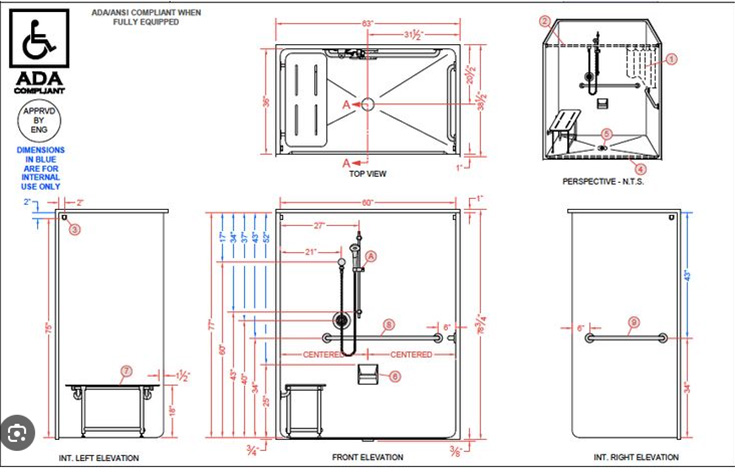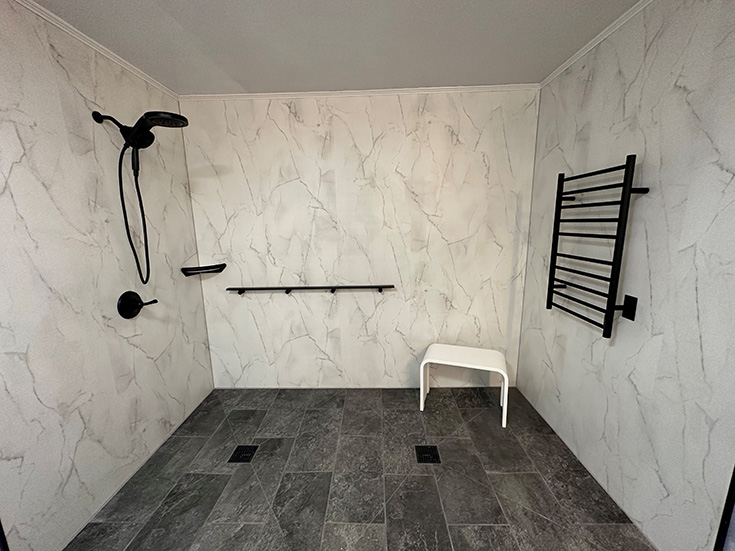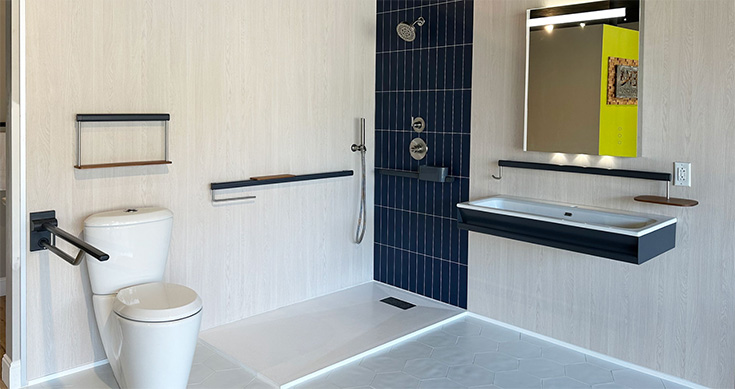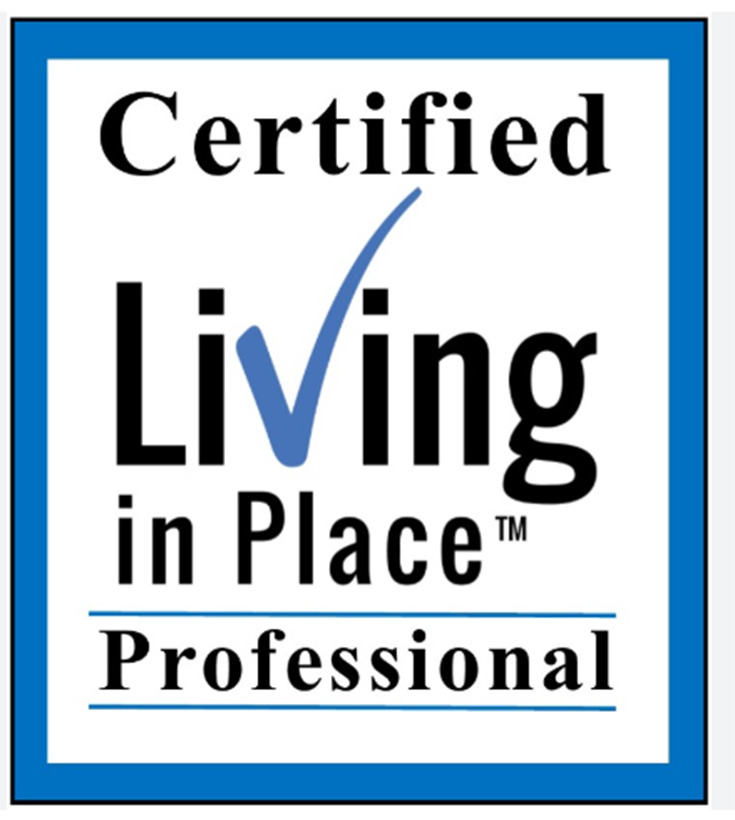Who can (and Should) Design, Supply, and Install your Accessible, Age in Place, or ADA Shower?

Whether you can hear (evil) father time knocking (or banging) on your door, or you (or a family member) have a debilitating disease, health, or developmental challenge – you know a ‘standard’ shower (and bathroom) can be something you despise and worry if it’ll be safe.
So, you’ve might to come to the conclusion you ‘want to get in front of aging’ (if there is such a thing) with an ‘age in place shower.’ Or you NEED to get a new shower completed ASAP due to a traumatic injury or physical or mental health condition of a family member. And in these cases, you may know figuring out who can (or should) design, supply and install your accessible, age in place, or ADA shower can be a major pain in the A** (and since this is a family-friendly blog, I can’t spell that out!).
And if this describes your situation, you’ve come to the right article.
My goal in this article is BIG.
I’m going to attempt to make it easier for you to understand the jargon around accessible, age in place, and ADA showers. In addition, I want to arm you with the right questions to ask so you will not only get the right shower – but one which’ll be safe, simple, and dare I say – even stylish. In addition, I’d like to help you find the right contractor to shepherd you along the way.
And even though I know it’s NOT sexy – I’m going to start in Section 1 with definitions so you can better understand what is an accessible, age in place or ADA shower is. And I’ll also define what an ‘accessible contractor’ or an ‘age in place’ contractor is. And (spoiler alert) one contractor be both.
Then in Section 2 – I’ll give you 11 questions to ask to find the best designer, supplier, and/or contractor to help with your job. So, now let’s dig into those fun, fun, fun definitions.
Section 1) What is an accessible, age in place, or ADA shower?
An accessible shower – which is also known as a roll in, or barrier free shower is one designed to be used safely and independently (if possible) by people with limited mobility.
This shower will make it simple for it’s owners to do the following:
- Get in and out of the shower – This is where a roll in – or barrier free design is important, and the size of the opening is critical.
- Reach the controls and shower supplies without a problem. Pay attention to the location of hand-held showers, niches, and shelves so everyone can use them – whether they shower standing, or in a seated position.
- Avoid falls – Grab bars and slip resistant flooring are important factors here.
- Maintain independence – Shower seats, and ramped entries can be helpful.
An age in place shower (also known as a universal design shower) is designed to be safe, comfortable, and accessible to allow people to stay in their homes and extend the time when it may be necessary to move into expensive community facilities (such as independent and assisted living).

On the Mend Medical
Age in place showers can include the following elements:
- A low profile shower curb – Many age in place remodels are tub to shower conversions to lessen the risk of falls by replacing the tub which is hard to step over with a low profile shower base. And the depressing reality is falls kill more older adults than cancer!
- Fold down seats or benches – Seating give a person the ability to shower without the strain of standing. And if you use a fold down seat, it’ll not only provide a safer place to shower – but it can be folded up making a roomier shower for those not using the seat.
- Grab bars – Decorative grab bars (which look more like towel bars) are doing away with the stigma of the ‘truck stop’ or ‘institutional’ looking grab bar no one wants.
- Non-slip flooring.
An ADA shower is a shower which follows the strict guidelines of the Americans with Disability Act. What’s most important to know about an ADA shower (and I know this point is confusing to many residential homeowners who think they need an ADA shower) is these guidelines are for public and commercial projects. They ARE NOT required for private residences.

The guidelines for ADA showers are rigid and include:
- Grab bars: Installed horizontally on the back wall and the sidewall opposite the shower seat. Grab bars should support a minimum of 250 lbs. of force.
- Shower controls: Located on the back wall, adjacent to the shower seat, and no more than 27 in from the seat wall. Controls should be accessible and operable from a seated position, and should not require tight grasping, pinching, or twisting of the wrist.
- Shower seat: If provided, the seat should be fixed to the wall and extend to within 3 in of the entry. The seat should span the width of the shower.
- Threshold: The threshold height should be no more than ½ in above the finished bathroom floor.
- Shower dimensions: Roll-in showers should be at least 30” x 60”.
- Soap dish: Should be recessed and mounted 38 into 48 in above the finish floor.
- Shower curtain: Can work well as an enclosure for all users.
- Pressure balanced mixing valve: Prevents scalding.
Section 1 – Who are home access and age in place contractors? Can they be one and the same? How can I find them?
When you set out to find a contractor to design, supply, and install your accessible, age in place, or ADA shower most people don’t realize there are specialists who can help. And these 2 specialists are called ‘home access contractors’ or ‘age in place’ contractors.
Since you may be wondering who these people are – and most importantly (especially in this world where finding a good contractor can be a needle in a haystack experience) where can you find one, you’ll want to read below.
Who is a home access contractor?
A home access contractor are contractors who work on ADA, accessible or age in place bath and shower projects. They’re comfortable not only working with homeowners, but also with health care professionals (like Occupational Therapists, Physical Therapists, etc.) to design bathrooms for people living with medical or behavioral challenges. Basically, they work in the mid-section of health care and construction.
Home access contractors will come to your home and do a ‘home assessment.’ Then they’ll recommend modifications for a safer home.
They have the knowledge of products and installation methods for bathrooms for people who not only want to ‘age in place’ (they’re getting older and want a safer bathroom) – but also those who were seriously injured (and may be working through Workmen’s Compensation or an insurance claim) have a debilitating disease, or are dealing with sensory, intellectual, or behavioral challenges.
If you’re wondering where to find a home access contractor here’s some ideas:
- Search ‘bathroom modifications’ in your local area. You’ll find companies who sell ‘Durable Medical Equipment’ (‘er wheelchairs, walkers, ramps, stairlifts etc.) also may have a contracting division which does bathroom remodeling (or bath modifications – like adding grab bars or widening doors).
- Go to VGM Live at Home. This organization has members who are home access contractors – and include some of the ‘best of the best’ in this field.
- Call 877-668-5888. Our company wholesales bathroom modification products to many home accessibility contractors and may be able to provide a referral for you.
Who is an age in place contractor?
An age in place contractor is often a ‘general remodeling contractor’ who has taken course work from the Home Builders Association to earn a CAPS certificate (Certified Aging in Place Specialist), or they have a CLIPP certification (from the Living in Place Institute). They are more knowledgeable about age in place design, products, and installations than a ‘general’ contractor.
These companies generally work in private homes (not public facilities which need ADA showers for example) and are experienced helping older homeowners to ‘age in place.’
They generally are not as versed (like a home access contractor) or experienced helping people with really challenging medical or behavioral challenges – and how those challenges impact the shower and bathroom design and installation approaches.
Is one of these contractors better than the other?
As someone who is CAPS certified and owns an age in place remodeling company in Cleveland Ohio – and who also wholesales grout free wall panels and bases to age in place sold to home access and age in place contractors across the country, I’ll tell you neither is ‘better’ than another.
From my experience though where the ‘age in place’ bathroom remodelers are more advanced is they have a better understanding how to make your bathroom not only safe, and simple to use – but also stylish. They’re more focused on trends and style – and can deliver a cooler finished project.
And where the ‘home access contractors’ are better is their deeper understanding of patient care, and how health care challenges (especially difficult ones) impact shower or bathroom design. And you’ll even find many home access contractors even started out as Occupational and Physical Therapists. They have a deep understanding of safety – but when it comes to style, many are focused on publicly funded projects in lower end homes and use more institutional looking products. However, this is a situation our company is trying to change with stylish wall surrounds and cool shower pans.

JTEK Solutions
Section 2) What questions should you ask to choose the right products (and contractor) to design, supply, and install your accessible, age in place, or ADA shower?
So – now that we’re done with those definitions (wow- wasn’t that fun?) – let’s get to the heart of the matter. What questions do you need to ask to find the right products – and contractor – for your accessible, age in place or ADA shower? Start here:
Question #1 – What’s your experience with accessible, age in place, or ADA showers? What certifications do you have?
What you DON’T want is a ‘contractor that doesn’t know his/her butt from a hole in the ground’ (Ok, that was a favorite line of my dad’s I had to throw in).
So – ask potential contractors what specific training (or certifications) they have in age in place or accessible remodeling. Are they a member of industry-leading groups like VGM Live at Home or their local remodeling or building association.
Have they done jobs like yours?
Question #2 – If style matters– ask, what safe, simple, AND stylish shower products can you get for an accessible, age in place, or ADA shower?
I’ll be brutally honest with you. Some people selling age in place showers have shower wall surrounds and bases which are as hot as your nearest hospital room (or wheelchair store). YUCK!
However, on the good side – age in place, accessible – or even ADA showers DO NOT have to be ugly.
In todays’ market there’s many cool options. Here’s some:
- Check out stylish grout free wall panels.
- Or consider a one-level tile shower floor which has no ramps, or thresholds to climb over.
- Or if you’re doing age in place shower – how about a cool stone shower pan.
Accessible, age in place, and ADA DOES NOT have to equal ugly. However, some contractors will go right to their ‘go to’ systems they use in lower income homes in publicly funded projects and pull out plastic wall panels and shower pans people love to hate (if you let them their ‘path of least resistance’ ugly products, they will!).
Question #3 – Can they help you get funding for your accessible, age in place, or ADA shower?
If only you had received your portion of Elon Musk’s Inheritance Fund (or had been one of his 8 children!). But I’m going to go out on a limb here and guess this isn’t the case for you.
And if you’re struggling with how to pay for this shower (especially if a family member suffered a traumatic injury and you had no time to plan) you may be not only worried about their safety – but how you’ll pay to make your home work again.
And this is a place where an on-top-of-the-game’ contractor can help. You’ll see there’s inventive financial products like reverse mortgages (which got a bad rap years ago – but can be smart ways to access equity). And if you want to learn more about reverse mortgages, listen to this podcast lead by Janet Engle of Homes Designs for Life.
Or a home access contractor may be familiar with programs through the Department of Aging or other such programs you may qualify for.
Or an age in place contractor may have 18 month terms or financing.
When confronted with a difficult remodeling and financial challenge like this don’t be afraid to ask for help and referrals.
Question #4 – Do they have tub to shower conversion experience? If so – how many projects have they done?
The most common accessible projects (in standard sized bathrooms) you’ll see in millions of homes are bathtub to shower conversions. And I know remodeling contractors who do hundreds of these projects in a single year!
So – when you look at a potential contractor’s web site see if they specifically call out their tub to shower conversion expertise and product offerings. This is a tell-tale sign they’re in the game.
Question #5 – What options are offered for the base or floor of your accessible, age in place, or ADA shower?
While I’ll admit the ‘floor’ (or shower base) is not the sexiest part of your shower – it is the foundation – and what the rest of the shower is built on. And if it fails, then you’ve got a (Notorious) B.I.G. problem.
What type of shower pans or one level wet room systems does your contractor offer? What are the warranties?
Will you need to maintain a tile floor – or is it a grout free product?

JTEK Solutions
If there’s a threshold, will your loved one be able to climb over it as they age (or their health condition worsens)?
Can you get an add on ramp kit or removable threshold so the space will be flexible for whatever happens in the future without the shower looking institutional when you sell the home?
Question #6 – Can they explain to you the impact of lighting and color on a well-designed accessible, age in place, or ADA shower?
Now here’s a depressing statistic if you’re 60 years or older (and I have to – unfortunately admit I’m in this category – unless I go ‘dyslexic’ on you and claim to be a dyslexic 46 year old!). I’ve heard you need 3 times more light as a 60 year old to see the same thing as a 20 year old! Bummer.
So, what does this have to do with a shower remodel?
Well – smart accessible or age in place remodelers will look to maximize natural light (possibly by adding a transom window or even a solar wall tube) or task lighting (to help shave inside or outside the shower with a mirror or LED medicine cabinet). They’ll also stay away from dark countertops where it’s hard to see where things begin and where they end.

Houzz
I guess there’s a reason I’m always pulling out my cell phone in a dark restaurant to see the menu. Hey, maybe I’ll bring along 3 – 20-year olds to help me out (although if I do they’ll likely make me pick up the tab…after all, 29 year old guys like me have more cash!). Ha! ha!
Question #7 – What’s your contractors mix of work done for private pay vs. publicly funded projects?
There’s nothing wrong with contractors who work with publicly financed jobs (unless it causes them cash flow problems). However, there is a difference in where these contractors focus their energies, and it has implications for the products they offer.
The ones who are heavily into publicly funded projects (vs. working to a large degree with individual homeowners) may be more volume driven and not as open to getting products which fit your style. And while these companies may be cheaper – they may not deliver as appealing a finished project.
Question #8 – Can they help you ‘see’ what your job will look like before you buy?
Have you ever bought something for your home (or a new outfit) – only to receive it and think, “That’s not AT ALL what I expected!” (and it’s usually not good when this happens).
And when it comes to an age in place, accessible or ADA shower – the last thing you want to experience is a shower or bathroom which reminds you of a hospital room – or Grandma’s house (even if you are a grandma – you STILL don’t want it to look like Grandma’s house – if you know what I mean).
It’s for this reason – you should pay attention to how your potential home access or age in place contractor presents their solutions to you.
Do you get to see actual job photos (in a bathroom presentation) where you can see ‘before/after’ shots?
Do they have a visualizer tool where you can change your selections and see if you like how things look together?
If you’re not a designer – and haven’t even had a bit role on Designing Woman (now that makes me sound old) you know selections can be tough if you’re not confident how to put patterns and colors together (or you DO NOT want to get stuck with a white, plasticky, shower system).
Question #9 – When can you get scheduled for an accessible, age in place, or ADA shower?
While you might have all the time in the world to ‘refresh’ your bathroom with a new age in place design (and that’s assuming Father Time doesn’t ‘grab you’ before it’s your time!)– the luxury of time may NOT be your friend if you have a family member who was involved in a serious accident or has a debilitating disease.
And this is where home access contractors are often Johnnie (or Janie…. don’t want to be sexist) on the spot. They’re used to working with the medical community in cases where time is of the essence. And as a matter of fact – one home access contractor I work with (On The Mend Medical owned by Liam O’Keefe) even had his team drive from Connecticut to Ohio in the middle of the night to pick up a shower base to turn around a job quickly. Now that’s service!

So, ask your contractor when can they get to the job – and do they have access to products (even in a tight time-frame) which aren’t UGLY (with a capital U!).
Question #10 – Is your accessible, age in place, or ADA shower a ‘master of their game?’
Have you ever met a contractor who came in with their dog-eared legal pad and messy truck – and think, “I really don’t think this guy (sorry to be sexist here) knows what the heck they’re doing, or their organization is suspect at best!”
And I’ll tell you (as a company who has a nationwide bathroom products wholesale division) there are contractors who are (literally) stuck in the mud when it comes to the products and processes they use.
They’re living in the (bad) old days.
They’re using behind-the-times installation approaches which don’t waterproof a bathroom properly or are using shower wall panels which – while cheaper – don’t reach the ceiling and require more maintenance from you.
They have limited product options because they don’t stay current on industry trends.
So – you may be asking how do you ensure you don’t get an ‘old-time’ contractor using behind the times methods?
One way is to look at their website (assuming they have one) and see if they’re involved in their industry associations and/or have certifications like being a CAPS or CLIPP certified contractor.
Another way is to see if they’re producing educational content (like accessible or age in place blogs, or videos) on either their web site and/or social media platforms. Progressive companies are educators!
Question #11 – Ask about warranties (and no this isn’t a joke, even if you’ve got more than a few gray hairs!).
I know when you talk to older people about product warranties and say a product has a ‘lifetime warranty,’ they’ll joke and say, “Whose lifetime (especially if they’re a bit in the ‘old’ stage of their lives)?”
And while I know warranties can be a slippery-slope (no bathroom pun intended), it’s an important question to address, especially if you’re purchasing a bathroom remodel which is SUPPOSED to last a long time (and if it doesn’t last you could be spending A LOT OF MONEY…..AGAIN, on a ‘BOBO’ – and if you’ don’t know what a BOBO is, it’s ‘you buy one, then you get to buy another one!’).
And while you may love products like tile shower walls and floors, what you may not realize (until it’s too late and you’re dealing with mold and maintenance problems), is most contractors provide either no guarantee or only a one year guarantee (yes you heard that right) on a tile bathroom floor or walls. In addition, if this tile-grouted system leaks, you’ll have a B-I-G problem on your hands which is costly to fix.
So, if you’re looking at this bathroom modification and renovation to be something you can count on for 10, 20 or ever 30 years, you need to talk to your contractor about warranties. How long are they? Who stands behind them? What can you expect if the product fails? What’s the history of this product?
Don’t gloss over warranties and end up stuck with a big bill years from now you didn’t anticipate.
So, has this article helped you have a better idea on how to choose an accessible, age in place or ADA shower contractor? Do you need help with products or a referral for your project?
I know finding an accessible, age in place, or ADA contractor (or a contractor of any sort for that matter) IS NOT simple. I hope these definitions and 11 questions have started you down the road to success.
However, if you need more insight on age in place products (like low profile shower pans, one level wet rooms, stylish grout free shower wall panels to name a few) and/or a referral for an accessible, age in place, or ADA contractor (I know a good number through my affiliation with the VGM Live at Home group), I (and my team) would be glad to help.
Call 877-668-5888 or click for a Free Design Consultation to get assistance from Bathroom Product Specialists.
And if you’re looking for an age in place bathroom contractor in Cleveland call 216-531-6085.
Thanks for reading (and putting up with my – at times – wacky humor!).
Mike
###
If you want more advice follow me on LinkedIn @MikeFoti.
And if you’re age in place contractor interested in being a dealer of shower wall panels, shower pans, glass shower door systems and freestanding or alcove tubs, call 888-467-7488 and ask for Mike.




















